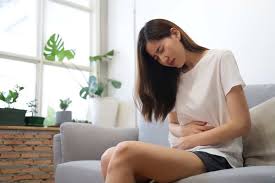A new review by US scientists has found that vitamin E may help reduce menstrual cramps.
1. What is dysmenorrhea?
Dysmenorrhea is pain or cramping in the lower abdomen, usually occurring just before and during menstruation. Dysmenorrhea is a common symptom of a woman’s menstrual cycle.
Many women only feel this pain is slightly uncomfortable and tiring. On the contrary, some have severe dysmenorrhea, which can affect their lives and activities for several days.
Dysmenorrhea is often characterized by increased levels of prostaglandins (or hormone-like substances) during menstruation, so inhibiting prostaglandin production has become the main way to treat dysmenorrhea.
To relieve pain during menstruation, you can use non-prescription anti-inflammatory drugs (NSAIDs) or birth control pills.

Some people have severe menstrual cramps that can affect their lives and activities for several days.
2. Why does vitamin E help relieve menstrual cramps?
Vitamin E is a fat-soluble antioxidant that has been shown to help keep skin healthy, boost immunity, protect the body’s cells from the harmful effects of free radicals, etc.
Studies have also shown that vitamin E supplementation can reduce pain during menstruation, including cramps.
Accordingly, taking vitamin E will reduce the amount of prostaglandin in the body. This can lead to overall pain and discomfort during menstruation and relax the uterine muscles. In addition, vitamin E can also reduce the duration and intensity of menstrual cramps as well as limit blood loss, and can even help reduce cramps, anxiety, cravings, and regulate the menstrual cycle.
However, taking vitamin E does not completely eliminate pain in primary dysmenorrhea. In addition, the effect of vitamin E on reducing menstrual cramps on each person is different.
3. How much should you drink?
To reduce menstrual cramps, experts recommend 15 mg/day for normal people and 19 mg/day for breastfeeding mothers. Note, when choosing vitamin E supplements, look for products containing natural vitamin E instead of synthetic vitamin E.
Some foods rich in natural vitamin E: Sunflower seeds, almonds, hazelnuts, tomatoes, mixed nuts, sweet potatoes, green leafy vegetables such as spinach, wheat germ oil, vegetable oil, kiwi fruit…
Experts say that there is no evidence that vitamin E from food has the same results as vitamin E supplements. However, foods rich in vitamin E in the diet can help improve overall health.
4. Risks of vitamin E supplementation
Like vitamins D, A and K, vitamin E is a fat-soluble vitamin, where excess amounts are stored in the body’s fatty tissues, accumulating over time, so there is a risk of vitamin E toxicity when supplemented in excess.
Typically, vitamin E toxicity can occur with daily doses of 1000 mg or more. Doses above 300 mg of vitamin E can also affect the effects of aspirin, warfarin, cyclosporine and tamoxifen.
Therefore, before wanting to use vitamin E supplements, you should talk to your doctor for advice and instructions on how to use them safely and effectively.





